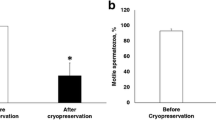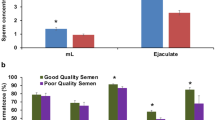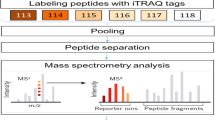Abstract
In the present study, we describe the proteome of porcine cauda epididymis fluid and spermatozoa by means of Multidimensional Protein Identification Technology (MudPIT). Ten sexually mature healthy boars were surgically castrated and epididymides were dissected to obtain the cauda epididymal content. Polled protein extracts of cauda epididymal fluid (CEF) and spermatozoa (CESperm) were loaded in an Agilent 1100 quaternary HPLC and peptides eluted from the microcapillary column were electro-sprayed directly into a LTQ Orbitrap XL mass spectrometer. Using bioinformatics, identified proteins were classified by their molecular functions, involvement in biological processes and participation in relevant metabolic pathways associated with spermatozoa physiology, fertility potential and protection. A total of 645 proteins were identified in the CEF, with epididymal-specific lipocalin-5, beta-hexosaminidase subunit beta precursor and phosphatidylethanolamine-binding protein 4 being the most abundant proteins found. A total of 2886 proteins were identified in the CESperm proteome with 81 proteins being considered more abundant (spectral counts > 100). CEF and CESperm data were compared and 345 proteins were present in both proteomes. Phosphatidylethanolamine-binding protein 4 precursor was the only protein found most abundant in both CEF and CESperm proteomes. Based on Gene Ontology analysis, we identified CEF and CESperm proteins associated with sperm protection against ROS and immune mediated response, glycosaminoglycan degradation, ubiquitin-proteasome system, metabolic process and maturation, modulation of acrosome reaction and ZP binding and oocyte penetration. These results provide a better comprehension about the molecular process and biological pathways involved in sperm epididymis maturation and establishment of the cauda epididymis sperm reservoir.








Similar content being viewed by others
References
Ashburner M, Ball CA, Blake JA, Botstein D, Butler H, Cherry JM, Davis AP, Dolinski K, Dwight SS, Eppig JT, Harris MA, Hill DP, Issel-Tarver L, Kasarskis A, Lewis S, Matese JC, Richardson JE, Ringwald M, Rubin GM, Sherlock G (2000) Gene ontology: tool for the unification of biology. Gene Ontol Consortium Nat Genet 25:25–29
Baska KM, Manandhar G, Feng D, Agca Y, Tengowski MW, Sutovsky M, Yi YJ, Sutovsky P (2008) Mechanism of extracellular ubiquitination in the mammalian epididymis. J Cell Physiol 215:684–696
Binette JP, Ohishi H, Burgi W, Kimura A, Suyemitsu T, Seno N, Schmid K (1996) The content and distribution of glycosaminoglycans in the ejaculates of normal and vasectomized men. Andrologia 28:145–149
Chabory E, Damon C, Lenoir A, Henry-Berger J, Vernet P, Cadet R, Saez F, Drevet JR (2010) Mammalian glutathione peroxidases control acquisition and maintenance of spermatozoa integrity. J Anim Sci 88:1321–1331
Chabory E, Damon C, Lenoir A, Kauselmann G, Kern H, Zevnik B, Garrel C, Saez F, Cadet R, Henry-Berger J, Schoor M, Gottwald U, Habenicht U, Drevet JR, Vernet P (2009) Epididymis seleno-independent glutathione peroxidase 5 maintains sperm DNA integrity in mice. J Clin Invest 119:2074–2085
Conesa A, Gotz S, Garcia-Gomez JM, Terol J, Talon M, Robles M (2005) Blast2GO: a universal tool for annotation, visualization and analysis in functional genomics research. Bioinformatics 21:3674–3676
Conrad M, Ingold I, Buday K, Kobayashi S, Angeli JP (2015) ROS, thiols and thiol-regulating systems in male gametogenesis. Biochim Biophys Acta 1850:1566–1574
Cowan AE, Myles DG (1993) Biogenesis of surface domains during spermiogenesis in the guinea pig. Dev Biol 155:124–133
Dacheux JL, Belghazi M, Lanson Y, Dacheux F (2006) Human epididymal secretome and proteome. Mol Cell Endocrinol 250:36–42
Dacheux JL, Belleannee C, Jones R, Labas V, Belghazi M, Guyonnet B, Druart X, Gatti JL, Dacheux F (2009) Mammalian epididymal proteome. Mol Cell Endocrinol 306:45–50
Dacheux JL, Castella S, Gatti JL, Dacheux F (2005) Epididymal cell secretory activities and the role of proteins in boar sperm maturation. Theriogenology 63:319–341
Dacheux JL, Dacheux F (2014) New insights into epididymal function in relation to sperm maturation. Reproduction 147:R27–R42
Dacheux JL, Paquignon M (1980) Relations between the fertilizing ability, motility and metabolism of epididymal spermatozoa. Reprod Nutr Dev 20:1085–1099
Dapino DG, Marini PE, Cabada MO (2006) Effect of heparin on in vitro capacitation of boar sperm. Biol Res 39:631–639
El-Taieb MA, Herwig R, Nada EA, Greilberger J, Marberger M (2009) Oxidative stress and epididymal sperm transport, motility and morphological defects. Eur J Obstet Gynecol Reprod Biol 144(Suppl 1):S199–S203
Emanuelsson O, Brunak S, von Heijne G, Nielsen H (2007) Locating proteins in the cell using TargetP, SignalP and related tools. Nat Protoc 2:953–971
Fränzel B, Wolters DA (2011) Advanced MudPIT as a next step toward high proteome coverage. Proteomics 11:3651–3656
Glickman MH, Ciechanover A (2002) The ubiquitin-proteasome proteolytic pathway: destruction for the sake of construction. Physiol Rev 82:373–428
Govindaraju A, Dogan S, Rodriguez-Osorio N, Grant K, Kaya A, Memili E (2012) Delivering value from sperm proteomics for fertility. Cell Tissue Res 349:783–793
Guyonnet B, Marot G, Dacheux JL, Mercat MJ, Schwob S, Jaffrezic F, Gatti JL (2009) The adult boar testicular and epididymal transcriptomes. BMC Genomics 10:369
Handrow RR, Lenz RW, Ax RL (1982) Structural comparisons among glycosaminoglycans to promote an acrosome reaction in bovine spermatozoa. Biochem Biophys Res Commun 107:1326–1332
Heberle H, Meirelles GV, da Silva FR, Telles GP, Minghim R (2015) InteractiVenn: a web-based tool for the analysis of sets through Venn diagrams. BMC Bioinformatics 16:169
Hermo L, Robaire B (2002) Epididymal cell types and their functions. In: Robaire B, Hinton BT (eds) The epididymis: from molecules to clinical practice. Springer, New York
Hinton BT, Palladino MA (1995) Epididymal epithelium: its contribution to the formation of a luminal fluid microenvironment. Microsc Res Tech 30:67–81
Koziorowska-Gilun M, Koziorowski M, Fraser L, Strzezek J (2011) Antioxidant defence system of boar cauda epididymidal spermatozoa and reproductive tract fluids. Reproduction in domestic animals =. Zuchthygiene 46:527–533
Krogh A, Larsson B, von Heijne G, Sonnhammer EL (2001) Predicting transmembrane protein topology with a hidden Markov model: application to complete genomes. J Mol Biol 305:567–580
Labas V, Spina L, Belleannee C, Teixeira-Gomes AP, Gargaros A, Dacheux F, Dacheux JL (2015) Analysis of epididymal sperm maturation by MALDI profiling and top-down mass spectrometry. J Proteome 113:226–243
Lenz RW, Ax RL, Grimek HJ, First NL (1982) Proteoglycan from bovine follicular fluid enhances an acrosome reaction in bovine spermatozoa. Biochem Biophys Res Commun 106:1092–1098
Liberda J, Manaskova P, Prelovska L, Ticha M, Jonakova V (2006) Saccharide-mediated interactions of boar sperm surface proteins with components of the porcine oviduct. J Reprod Immunol 71:112–125
Liberzon A, Birger C, Thorvaldsdottir H, Ghandi M, Mesirov JP, Tamayo P (2015) The Molecular Signatures Database (MSigDB) hallmark gene set collection. Cell Syst 1:417–425
Martin-DeLeon PA (2015) Epididymosomes: transfer of fertility-modulating proteins to the sperm surface. Asian J Androl 17:720–725
McDonald WH, Tabb DL, Sadygov RG, MacCoss MJ, Venable J, Graumann J, Johnson JR, Cociorva D, Yates JR 3rd (2004) MS1, MS2, and SQT-three unified, compact, and easily parsed file formats for the storage of shotgun proteomic spectra and identifications. Rapid Commun Mass Spectrom 18:2162–2168
Moura AA, Souza CE, Stanley BA, Chapman DA, Killian GJ (2010) Proteomics of cauda epididymal fluid from mature Holstein bulls. J Proteome 73:2006–2020
NRC (2012) Nutrient requirements of swine. The National Academies Press, Washington, DC
Park K, Jeon S, Song Y-J, Yi LSH (2012) Proteomic analysis of boar spermatozoa and quantity changes of superoxide dismutase 1, glutathione peroxidase, and peroxiredoxin 5 during epididymal maturation. Anim Reprod Sci 135:53–61
Pena S Jr, Summers P, Gummow B, Paris DB (2015) Oviduct binding ability of porcine spermatozoa develops in the epididymis and can be advanced by incubation with caudal fluid. Theriogenology 83:1502–1513
Perez-Patino C, Barranco I, Parrilla I, Valero ML, Martinez EA, Rodriguez-Martinez H, Roca J (2016) Characterization of the porcine seminal plasma proteome comparing ejaculate portions. J Proteome 142:15–23
Perez-Patino C, Parrilla I, Li J, Barranco I, Martinez EA, Rodriguez-Martinez H, Roca J (2018) The proteome of pig spermatozoa is remodeled during ejaculation. Molecular & cellular proteomics, MCP
Petersen TN, Brunak S, von Heijne G, Nielsen H (2011) SignalP 4.0: discriminating signal peptides from transmembrane regions. Nat Methods 8:785–786
Pfaffl MW (2001) A new mathematical model for relative quantification in real-time RT-PCR. Nucleic Acids Res 29:e45
Ramakers C, Ruijter JM, Deprez RH, Moorman AF (2003) Assumption-free analysis of quantitative real-time polymerase chain reaction (PCR) data. Neurosci Lett 339:62–66
Rivlin J, Mendel J, Rubinstein S, Etkovitz N, Breitbart H (2003) Role of hydrogen peroxide in sperm capacitation and acrosome reaction. Biol Reprod 70(2):518–522
Roberts KP, Wamstad JA, Ensrud KM, Hamilton DW (2003) Inhibition of capacitation-associated tyrosine phosphorylation signaling in rat sperm by epididymal protein Crisp-1. Biol Reprod 69:572–581
Rodriguez-Martinez H (2007) Role of the oviduct in sperm capacitation. Theriogenology 68(Suppl 1):S138–S146
Rodriguez-Martinez H, Tienthai P, Suzuki K, Funahashi H, Ekwall H, Johannisson A (2001) Involvement of oviduct in sperm capacitation and oocyte development in pigs. Reprod (Cambridge, England) Suppl 58:129–145
Ruijter JM, Ramakers C, Hoogaars WM, Karlen Y, Bakker O, van den Hoff MJ, Moorman AF (2009) Amplification efficiency: linking baseline and bias in the analysis of quantitative PCR data. Nucleic Acids Res 37:e45
Santi L, Beys-da-Silva WO, Berger M, Calzolari D, Guimaraes JA, Moresco JJ, Yates JR 3rd (2014) Proteomic profile of Cryptococcus neoformans biofilm reveals changes in metabolic processes. J Proteome Res 13:1545–1559
Sostaric E, van de Lest CH, Colenbrander B, Gadella BM (2005) Dynamics of carbohydrate affinities at the cell surface of capacitating bovine sperm cells. Biol Reprod 72:346–357
Sullivan R, Frenette G, Girouard J (2007) Epididymosomes are involved in the acquisition of new sperm proteins during epididymal transit. Asian J Androl 9:483–491
Sullivan R, Saez F (2013) Epididymosomes, prostasomes, and liposomes: their roles in mammalian male reproductive physiology. Reproduction 146:R21–R35
Sutovsky P (2003) Ubiquitin-dependent proteolysis in mammalian spermatogenesis, fertilization, and sperm quality control: killing three birds with one stone. Microsc Res Tech 61:88–102
Sutovsky P, Moreno R, Ramalho-Santos J, Dominko T, Thompson WE, Schatten G (2001) A putative, ubiquitin-dependent mechanism for the recognition and elimination of defective spermatozoa in the mammalian epididymis. J Cell Sci 114:1665–1675
Syntin P, Dacheux F, Druart X, Gatti JL, Okamura N, Dacheux JL (1996) Characterization and identification of proteins secreted in the various regions of the adult boar epididymis. Biol Reprod 55:956–974
Syntin P, Dacheux J-L, Dacheux F (1999) Postnatal development and regulation of proteins secreted in the boar epididymis. Biol Reprod 61:1622–1635
Tabb DL, McDonald WH, Yates JR 3rd (2002) DTASelect and contrast: tools for assembling and comparing protein identifications from shotgun proteomics. J Proteome Res 1:21–26
Talevi R, Gualtieri R (2001) Sulfated glycoconjugates are powerful modulators of bovine sperm adhesion and release from the oviductal epithelium in vitro. Biol Reprod 64:491–498
Tengowski MW, Sutovsky P, Hedlund LW, Guyot DJ, Burkhardt JE, Thompson WE, Sutovsky M, Johnson GA (2005) Reproductive cytotoxicity is predicted by magnetic resonance microscopy and confirmed by ubiquitin-proteasome immunohistochemistry in a theophylline-induced model of rat testicular and epididymal toxicity. Microsc Microanal 11:300–312
Therien I, Bergeron A, Bousquet D, Manjunath P (2005) Isolation and characterization of glycosaminoglycans from bovine follicular fluid and their effect on sperm capacitation. Mol Reprod Dev 71:97–106
Vernet P, Aitken RJ, Drevet JR (2004) Antioxidant strategies in the epididymis. Mol Cell Endocrinol 216:31–39
Watanabe K, Taskesen E, van Bochoven A, Posthuma D (2017) Functional mapping and annotation of genetic associations with FUMA. Nat Commun 8:1826
Wolters DA, Washburn MP, Yates JR 3rd (2001) An automated multidimensional protein identification technology for shotgun proteomics. Anal Chem 73:5683–5690
Xu T, Venable JD, Park SK, Lu B, Liao L, Wohlschlegel J, Hewel J, Yates JR (2006) ProLuCID, a fast and sensitive tandem mass spectra-based protein identification program. Mol Cell Proteomics 5:S174
Yanagimachi R (1994) Mammalian fertilization. In: Knobil E, Neill JD (eds) The physiology of reproduction. Raven Press, New York, pp 189–317
Zaja IZ, Samardzija M, Vince S, Sluganovic A, Strelec S, Suran J, DelVechio I, Duricic D, Ostovic M, Valpotic H, Milinkovic-Tur S (2016) Antioxidant protection and lipid peroxidation in testes and different parts of epididymis in boars. Theriogenology 86:2194–2201
Zhou W, De Iuliis GN, Dun MD, Nixon B (2018) Characteristics of the epididymal luminal environment responsible for sperm maturation and storage. Front Endocrinol (Lausanne) 9:59
Zigo M, Jonakova V, Manaskova-Postlerova P, Kerns K, Sutovsky P (2019) Ubiquitin-proteasome system participates in the de-aggregation of spermadhesin and DQH protein during boar sperm capacitation. Reproduction
Acknowledgments
The authors wish to thank the Associação de Criadores de Suínos do Rio Grande do Sul (ACSURS) for the provision of reproductive tissue samples. The authors would also like to thank Prof. Dr. Verônica Contini for contributions in the data analysis.
Funding
This work was supported by the Conselho Nacional de Desenvolvimento Científico e Tecnológico (CNPq) grant 447251/2014-7, Fundação de Amparo à Pesquisa do Estado do Rio Grande do Sul (FAPERGS) grant 16/2551-0000223-1 and Fundação Vale do Taquari de Educação e Desenvolvimento Social (FUVATES) grant 08/Reitoria/Univates/2016. Mrs. Laura Espíndola Argenti and Mrs. Ana Paula Binato de Souza were CAPES scholarship recipients.
Author information
Authors and Affiliations
Corresponding author
Ethics declarations
Conflict of interest
The authors declare that there is no conflict of interest.
Ethical approval
All procedures with animals described in this article were previously approved by the Local Animal Experimentation Ethics Committee (protocol 001/2015) and according to the Brazilian Animal Welfare legislation.
Additional information
Publisher’s note
Springer Nature remains neutral with regard to jurisdictional claims in published maps and institutional affiliations.
Rights and permissions
About this article
Cite this article
Weber, A., Argenti, L.E., de Souza, A.P.B. et al. Ready for the journey: a comparative proteome profiling of porcine cauda epididymal fluid and spermatozoa. Cell Tissue Res 379, 389–405 (2020). https://doi.org/10.1007/s00441-019-03080-0
Received:
Accepted:
Published:
Issue Date:
DOI: https://doi.org/10.1007/s00441-019-03080-0




